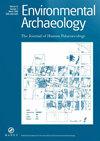燕麦[Avena sativa (L.)]花序苞片的植片在什么条件下会自发荧光?
IF 1.1
3区 地球科学
0 ARCHAEOLOGY
引用次数: 0
摘要
我们之前在考古学背景下进行的研究表明,植物残片在受到火和热的作用时会产生自发荧光。本研究试图探究植物晶体在暴露于火和热的条件下产生自发荧光的原因。本文章由计算机程序翻译,如有差异,请以英文原文为准。
Under What Conditions do the Inflorescence Bract Phytoliths of Oat [Avena sativa (L.)] Become Autofluorescent?
Our previous research from archaeological contexts suggested that phytoliths become autofluorescent when exposed to fire and heat. The present study is an attempt to investigate the conditions unde...
求助全文
通过发布文献求助,成功后即可免费获取论文全文。
去求助
来源期刊

Environmental Archaeology
GEOSCIENCES, MULTIDISCIPLINARY-
CiteScore
4.80
自引率
0.00%
发文量
32
期刊介绍:
Environmental Archaeology: The Journal of Human Palaeoecology aims to publish contributions on all aspects of environmental archaeology, from methodology to synthesis and theory.
Environmental Archaeology is an international peer-reviewed periodical which welcomes contributions that consider the interaction between humans and their environment in the archaeological and historical past. This broad scope embraces papers covering a range of environmental specialisms within archaeology, such as archaeobotany, archaeozoology (both vertebrate and invertebrate), palynology, geoarchaeology, biological anthropology, as well as more synthetic and theoretical approaches to the past human environment. Assemblage and site reports are not encouraged unless these can demonstrate significant new insights in environmental archaeology. Contributions may take the form of substantial research papers or shorter reports and may include, for instance, new techniques, philosophical discussions, current controversies and suggestions for new research. The journal also provides its readership with critical appraisal of recent academic scholarship through its regular books review section.
 求助内容:
求助内容: 应助结果提醒方式:
应助结果提醒方式:


